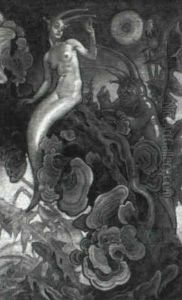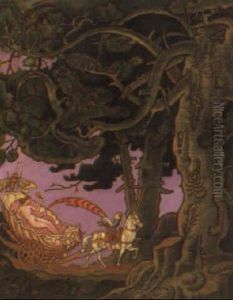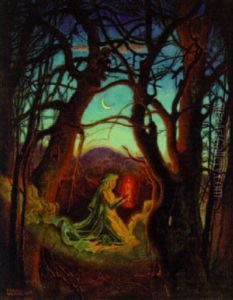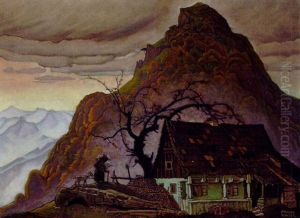Franz Wacik Paintings
Franz Wacik was an Austrian illustrator and graphic artist, renowned for his detailed and imaginative works. Born on September 30, 1883, in Gmünd, Austria, Wacik showed an early talent for art and pursued his passion by studying at the Academy of Fine Arts Vienna under the guidance of renowned artists such as Christian Griepenkerl and William Unger. His education at the academy provided him with a strong foundation in traditional techniques and the fine arts, which he would later infuse with his own unique style and vision.
During his career, Wacik became known for his book illustrations, ex-libris designs, posters, and graphic works. He was part of the vibrant Viennese art scene during the early 20th century, which was a melting pot of innovation, with artists exploring new forms of expression and contributing to movements such as Art Nouveau and Secessionism. Wacik's illustrations often featured fairy tale and fantasy elements, with a particular emphasis on intricate line work and a keen eye for detail. His style was characterized by a blend of romanticism and realism, often imbued with a sense of whimsy and enchantment.
Wacik's contributions to the field of book illustration were significant, and he illustrated numerous books for both children and adults. His illustrations helped to bring stories to life, capturing the imagination of readers and adding a visual layer to the narrative. He also created a number of ex-libris, which are personalized bookplates used to indicate the owner of a book. These ex-libris designs are highly collectible today and are appreciated for their artistry and craftsmanship.
In addition to his book-related work, Wacik also produced posters that reflected the Art Nouveau style, characterized by its elegant lines and decorative elements. His posters often advertised cultural events and products, demonstrating his ability to apply his artistic skills to commercial endeavors.
Franz Wacik's career was cut short by his untimely death on March 17, 1938, in Mödling, near Vienna. Despite his relatively short life, his legacy endures through his creative output, which continues to be celebrated and studied by art historians and enthusiasts. Wacik's work remains a testament to the flourishing art scene in Vienna during the early 20th century and his role as a key figure in the field of illustration and graphic arts.























